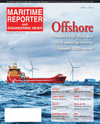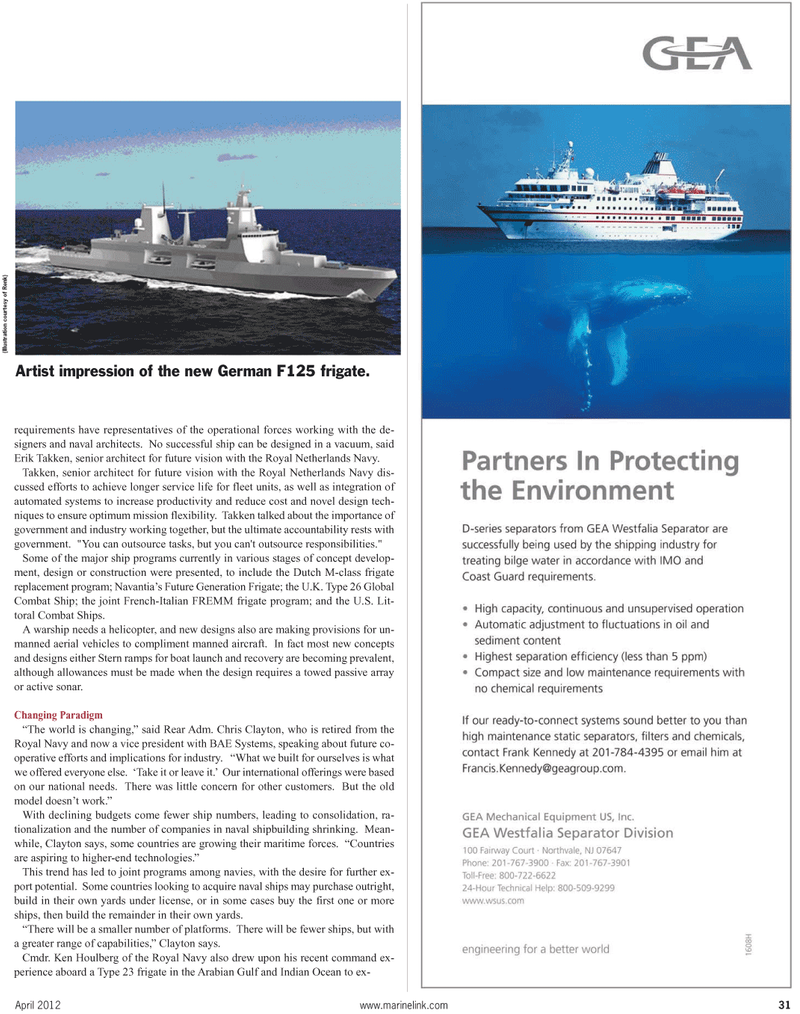
Page 31: of Maritime Reporter Magazine (April 2012)
Offshore Deepwater Annual
Read this page in Pdf, Flash or Html5 edition of April 2012 Maritime Reporter Magazine
April 2012www.marinelink.com 31requirements have representatives of the operational forces working with the de- signers and naval architects. No successful ship can be designed in a vacuum, said Erik Takken, senior architect for future vision with the Royal Netherlands Navy. Takken, senior architect for future vision with the Royal Netherlands Navy dis- cussed efforts to achieve longer service life for fleet units, as well as integration of automated systems to increase productivity and reduce cost and novel design tech- niques to ensure optimum mission flexibility. Takken talked about the importance of government and industry working together, but the ultimate accountability rests with government. "You can outsource tasks, but you can't outsource responsibilities." Some of the major ship programs currently in various stages of concept develop- ment, design or construction were presented, to include the Dutch M-class frigate replacement program; Navantias Future Generation Frigate; the U.K. Type 26 Global Combat Ship; the joint French-Italian FREMM frigate program; and the U.S. Lit- toral Combat Ships.A warship needs a helicopter, and new designs also are making provisions for un- manned aerial vehicles to compliment manned aircraft. In fact most new concepts and designs either Stern ramps for boat launch and recovery are becoming prevalent, although allowances must be made when the design requires a towed passive array or active sonar. Changing Paradigm The world is changing,? said Rear Adm. Chris Clayton, who is retired from the Royal Navy and now a vice president with BAE Systems, speaking about future co- operative efforts and implications for industry. What we built for ourselves is what we offered everyone else. Take it or leave it. Our international offerings were based on our national needs. There was little concern for other customers. But the old model doesnt work.? With declining budgets come fewer ship numbers, leading to consolidation, ra- tionalization and the number of companies in naval shipbuilding shrinking. Mean- while, Clayton says, some countries are growing their maritime forces. Countries are aspiring to higher-end technologies.? This trend has led to joint programs among navies, with the desire for further ex- port potential. Some countries looking to acquire naval ships may purchase outright, build in their own yards under license, or in some cases buy the first one or more ships, then build the remainder in their own yards. There will be a smaller number of platforms. There will be fewer ships, but with a greater range of capabilities,? Clayton says. Cmdr. Ken Houlberg of the Royal Navy also drew upon his recent command ex- perience aboard a Type 23 frigate in the Arabian Gulf and Indian Ocean to ex- Artist impression of the new German F125 frigate. (Illustration courtesy of Renk)

 30
30

 32
32
